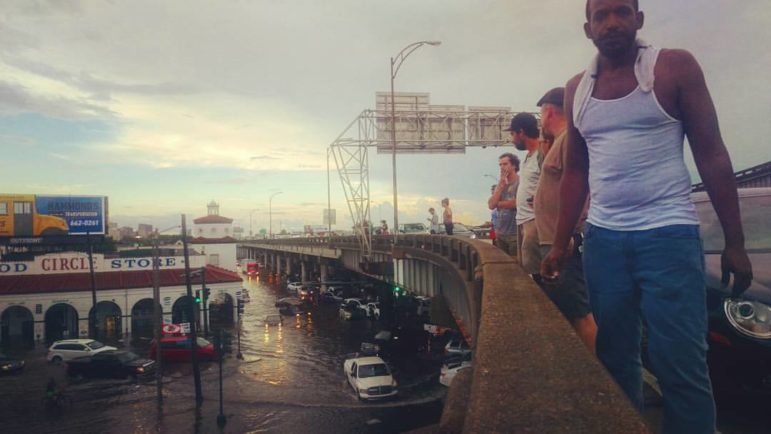
Like many New Orleans residents, I was stuck in traffic on the afternoon of Aug. 5 when torrential rains overwhelmed the drainage system and inundated streets. At the time, I didn’t realize how fortunate I was to get safely home without losing my vehicle to high water.
As New Orleans residents, we have made our peace with flooded intersections during heavy thunderstorms. Curbed streets — typically the lowest spot on any block — are effectively designed to hold water until it can drain into catch basins.
But Aug. 5 was different: Instead of draining steadily, the waters remained or even seemed to rise in some low-lying neighborhoods. Only later did we learn that this was due in part to out-of-commission pumps and an inadequate power supply.
It was a visceral reminder that life in our city depends on a unique pumped drainage system parts of which are more than a century old. When that system fails, lives, livelihoods and property are at risk. Cars and businesses flood; homes may be cut off from ambulances and fire trucks; hourly workers find themselves stuck and unpaid.
Before Aug. 5, I, like many voters, expected our city’s upcoming mayoral and City Council elections to revolve around crime and public safety. But the flooding and subsequent upheaval at the Sewerage and Water Board has changed all that. Candidates and voters alike were reminded that water management is a public safety issue.
A poorly managed response brought about resignations and retirements at the Sewerage and Water Board and the Department of Public Works. The Landrieu administration and City Council found new resources in the short term, including generators and vacuum trucks to clean clogged catch basins. The underlying challenges remain, however.
New Orleans’ water management is fractured, both literally and figuratively. Local drainage assets are split among two agencies, both of which lack the skilled staff and revenue adequate for operations and maintenance.
Additional departments are charged with floodplain management, hazard mitigation, public lands, and the oversight of the comprehensive zoning ordinance provisions for storm water management. Still other state and federal agencies are responsible for coastal restoration and hurricane surge protection.
The new political reality demands both a command of the issue and a plan of action.
Those of us who advocate for the use of nature-based solutions known as “green infrastructure” are all too familiar with this alphabet soup of agencies. But we’ve also seen New Orleans make progress. When large-scale FEMA- and HUD-backed green infrastructure projects come online in a few years, they will significantly relieve pressure on the conventional drainage system in an event like the Aug. 5 rainfall.
For example, the city will use Hazard Mitigation Grant Funds to install green infrastructure across 14 blocks near the intersection of West End and Robert E. Lee boulevards in Lakeview. In essence, the plans call for transforming alleyways into manicured French drains. Streets will get improved landscaping and storm water capacity. Hydrological models show that as a result flooding will be lessened across nearly 30 blocks.
A project between Hagan and Lafitte avenues in Mid-City will add underground rainwater storage at Easton Park, permeable sidewalks, and bioswales to absorb more than 3.5 inches of rain across the project area. To put that in context: the intense thunderstorm on Aug. 5 dropped more than 8 inches in Mid-City, rendering the low-lying intersection of Conti Street and Jefferson Davis Parkway impassable. So, while green infrastructure isn’t a panacea, it makes a substantial contribution to our climate readiness.
The “living with water” vision espoused in the Greater New Orleans Urban Water Plan has always been a hybrid “gray-green” system, one that combines improved absorption with the sluicing of storm water to points outside the levee system. Green infrastructure is a wise investment, but no replacement for pumped drainage. Similarly, a “multiple lines of defense” approach to hurricane protection calls for restoring coastal wetlands and maintaining our levees and floodwalls.
Smart voters can disagree about proposals to restructure, centralize or privatize authority for water management now being bandied about by candidates and pundits. But one thing is clear to me: Fixing New Orleans’ fractured drainage system requires creating a shared vision.
That’s why I’m looking forward to hearing directly from eight candidates on Sept. 14 at a Mayoral Forum on Flood Risk and Adapting to our Changing Environment. The public forum takes place at New Orleans Jazz Market, 1436 Oretha Castle Haley Blvd. Doors open at 5 p.m.*
While candidates can be forgiven for not discussing water management in July, the new political reality demands both a command of the issue and a plan of action. The Sept. 14 forum, which features questions submitted by experts and residents, is an important opportunity for voters to hear directly from the men and women who would be our next mayor.
Nathan Lott, a resident of the Carrollton neighborhood, is director of the Water Collaborative of Greater New Orleans, a multidisciplinary network of water sector professionals and stakeholders. You can learn more about their work here. Lott holds a Master’s in Preservation Studies from Tulane School of Architecture, where he studied climate change and resilience at historic sites.
The opinion section is a community forum. Views expressed are not necessarily those of The Lens or its staff. To propose an idea for a column, contact Lens founder Karen Gadbois.
*Correction: This address was wrong in the original post. (Sept. 14, 2017)


